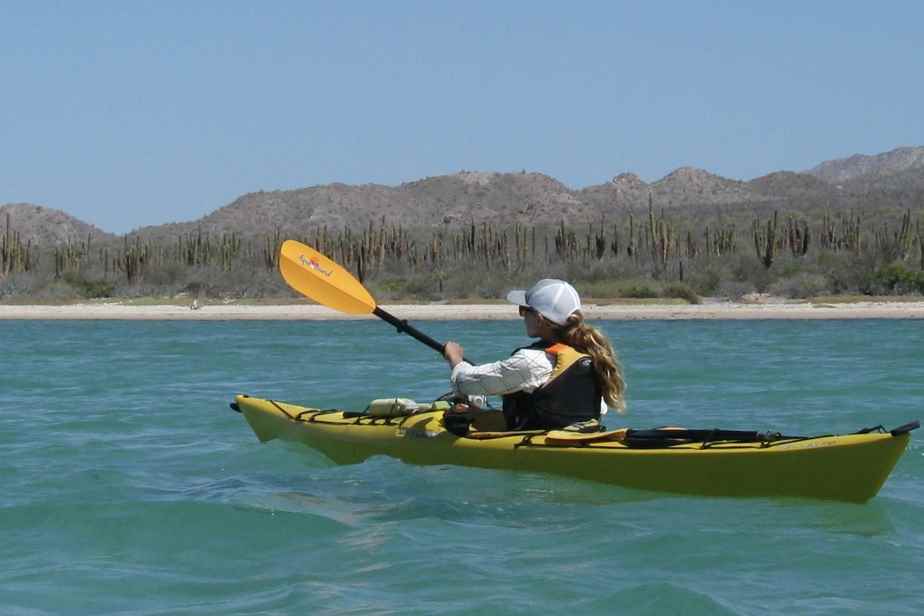The stars gradually faded away. Only two very bright points resist the rising day, Venus and Jupiter. The reddish glow of the sun emerging on the horizon, however, ends up making them disappear in turn.
Posted at 11:30 a.m.
This show, we see it comfortably wrapped up in our sleeping bag under an open tent in the morning breeze. As soon as the sun is up for good, it will be warm, it will be time to go out to dismantle the camp and have breakfast on the beach.

PHOTO MARIE TISON, THE PRESS
Early in the morning, before departure, it is still a bit chilly. But the colors are particularly warm.
It’s the little routine of a sea kayaking expedition in Baja California, or Baja California, Mexico, on the Sea of Cortez side.

PHOTO MARIE TISON, THE PRESS
A few fishing families have taken up residence on a tiny rocky islet, El Pardito.
San Jose Island
We load the kayaks and leave the island of San Francisco to head towards the island of San José. But on the way, we make a brief stop at a tiny islet, El Pardito, to buy some fresh fish for supper, a yellowtail amberjack that the village fishermen caught during the night.

PHOTO MARIE TISON, THE PRESS
Dolphins don’t care about kayakers, busy feeding or frolicking. Or do both at the same time.
During the crossing to the island of San José, dolphins approach without paying the slightest attention to us. They are too busy splitting the surface of the sea, diving and then jumping out of the water in an amazing choreography.
The island of San José offers us another kind of spectacle, a forest of mangrove trees well protected by a stone barrier. This greenery is stunning in the mostly desert landscape of Baja California.

PHOTO MARIE TISON, THE PRESS
The majestic cardon cactus, emblem of Baja California
However, the desert has its own beauty. Here, it is made up of hills where a few cacti grow (very slowly), including the majestic cardoon, the emblem of Baja California. It is unusual to see these desert plants rubbing shoulders with sparkling blue or turquoise water.
The terrain takes on various colors depending on the chemical composition of the soil. Cliffs along the water thus present contrasting strata: a green layer, a white layer, a green layer, an ocher layer, a green layer, and then red.
There is life. The birds, in particular, are numerous: cormorants, pelicans, frigates.

PHOTO MARIE TISON, THE PRESS
A heron perches above a rare mangrove forest.
The sea, above all, has not finished having surprises in store for us. Sometimes shoals of fish, pursued by some predator, leap above the water in a shimmering cloud.
And here is a group of big fish trying to get away from the group of kayakers. However, I sail a little aside and I see the shoal rushing in my direction. At first, it’s fascinating. But the shoal doesn’t seem to want to change its trajectory and I’m afraid soon to see these jumping fish hitting me head-on. Phew, they dive at the last moment to get under my kayak. I’m really hot.

PHOTO MARIE TISON, THE PRESS
Camp is set up on a beach nestled between two rocky cliffs.
Under water
Fortunately, we arrive at our new campsite and, before setting up the tents, we will freshen up with a little snorkeling session. It’s time to go visit these naughty fish and their little friends.

PHOTO MARIE TISON, THE PRESS
No one is in a hurry. We set up camp quietly, not quickly, on the beach.
Fish from the Sea of Cortez (or Gulf of California) are particularly colorful: the elegant damselfish, with its white bar and yellow tail; the spectacular horned zangle, with its long upper fin; the Rainbow Napoleon of Cortez, with its dazzling colors; the sergeant major, with his crossbars; the guinea fowl puffer fish, with its many white pimples… Not to mention the sea turtle and the ray which can appear without warning.
In spring, the water is not particularly warm. Better to wear a wetsuit to be able to have a good time underwater without discomfort. Or, we can favor the fall. After a hot summer, the water is noticeably warmer.
It feels good to get out of the sea and walk on the warm sand as cocktail hour approaches, while waiting for a good grilled yellowtail amberjack that will end the day in style.
There are a wide variety of sea kayaking packages to satisfy maniacs who love epic crossings, but also beginners who just want to take it easy. Just be well informed.
Learn more
-
- 32℃
- This is the average maximum temperature in Baja California Sur (Baja California Sur), one of the hottest regions in Mexico.
source: WorldData.com

